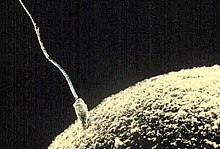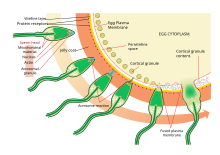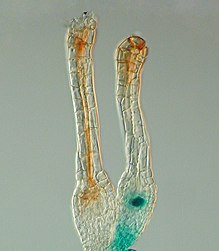Egg cell
[clarification needed] When egg and sperm fuse during fertilisation, a diploid cell (the zygote) is formed, which rapidly grows into a new organism.Studies performed on humans, dogs, and cats in the 1870s suggested that the production of oocytes (immature egg cells) stops at or shortly after birth.A review of reports from 1900 to 1950 by zoologist Solomon Zuckerman cemented the belief that females have a finite number of oocytes that are formed before they are born.[10] The ovum is one of the largest cells in the human body, typically visible to the naked eye without the aid of a microscope or other magnification device.[13] Mammalian ova contain only a tiny amount of the nutritive yolk, for nourishing the embryo in the early stages of its development only.[13] In the oviparous animals (all birds, most fish, amphibians and reptiles), the ova develop protective layers and pass through the oviduct to the outside of the body.The typical bryophyte archegonium consists of a long neck with a wider base containing the egg cell.[14] In the moss Physcomitrella patens, the Polycomb protein FIE is expressed in the unfertilised egg cell (Figure, right) as the blue colour after GUS staining reveals.




Original video animationOva (disambiguation)corona radiataAnatomical terms of microanatomyfemalereproductivegameteanisogamousreproduce sexuallymotileoogamousoosporefertilisationdiploidzygoteWilliam Harveyspontaneous generationpreformationismKarl Ernst von BaerOskar HertwiggonadsovariesmammalsoogenesisoocytesSolomon Zuckermanovarian stem cellsmicroscopenucleusgerminal vesiclenucleolusgerminal disccytoplasmhyaloplasmdeutoplasmalbuminoidMammalianembryooviparousamphibiansreptilesoviductmitochondriablastocystovoviviparousinvertebrateshaploidgametophytearchegoniamitosisbryophytesporophyteseed plantsfertilizationflowering plantsmicropylepollinationplant ovarydispersalgerminationseedlingPhyscomitrella patensPolycombGUS stainingInseminationMenstrual cycleOva bankOvulationPolar bodyPregnancySpawn (biology)Needham, JosephReski, RalfSexual dimorphismSexual differentiationFeminizationVirilizationSex-determination systemTemperature-dependentHaplodiploidySex chromosomeTestis-determining factorHermaphroditeSequential hermaphroditismSimultaneous hermaphroditismIntersexparasexualitySex as a biological variableSexualreproductionEvolution of sexual reproductionAnisogamyIsogamyGerm cellReproductive systemSex organMatingMeiosisGametogenesisSpermatogenesisspermatozoonExternalInternalSexual selectionPlant reproductionFungal reproductionSexual reproduction in animalsSexual intercoursePenile–vaginal intercourseCopulationHormonal motivationHuman reproductionLordosis behaviorPelvic thrustSexualityPlant sexualityAnimal sexualityHuman sexualityMechanicsDifferentiationActivityHuman physiologysexual reproductionMenarcheMenstruationFollicular phaseLuteal phase